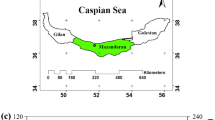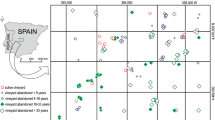Abstract
Background and aims
Pioneer plants may improve the ecological restoration of degraded ultramafic areas by plant-soil interaction processes. In this study, we assess the effect of the pioneer actinorhizal tree C. terminale (Casuarinaceae) on the recovery of plant communities and soil functions on degraded tropical ultramafic sites.
Methods
Soil and plant samples were collected along a tree-age gradient in two degraded ultramafic sites in Sabah (Northern Borneo, Malaysia): a Technosol and a Leptosol. Chemical composition of plants and soils, and biological activity of soils were assessed at both sites. Plant colonisation was assessed by plot vegetation surveys.
Results
An improvement in soil fertility parameters (pH reduction from 8.5 to 6.8, an increase in the concentrations of several nutrients and enhanced soil enzyme activities) was observed along the C. terminale age gradient. However, plant cover and diversity was only improved around mature trees at the site that was not impacted by mining.
Conclusion
C. terminale promotes the recovery of several soil functions, mainly related to the storage and recycling of N, P, K, S. Besides plant-soil feedback, other environmental factors (i.e. exposition to sunlight, drought) may play an important role on revegetation of ultramafic soils.







Similar content being viewed by others
References
Adam G, Duncan H (2001) Development of a sensitive and rapid method for the measurement of total microbial activity using fluorescein diacetate (FDA) in a range of soils. Soil Biol Biochem 33:943–951
Adhikari K, Hartemink AE (2016) Linking soils to ecosystem services—a global review. Geoderma 262:101–111
Alexander EB (2004) Serpentine soil redness, differences among peridotite and serpentinite materials, Klamath Mountains, California. Int Geol Rev 46:754–764
Benson DR, Dawson JO (2007) Recent advances in the biogeography and genecology of symbiotic Frankia and its host plants. Physiol Plant 130:318–330
Binkley DAN, Giardina C (1998) Why do tree species affect soils? The warp and woof of tree-soil interactions. In: Plant-induced soil changes: processes and feedbacks. Springer, pp 89–106
Bolan NS, Hedley MJ, White RE (1991) Processes of soil acidification during nitrogen cycling with emphasis on legume based pastures. Plant Soil 134:53–63
Bradshaw A (1997) Restoration of mined lands—using natural processes. Ecol Eng 8:255–269
Bradshaw A (2000) The use of natural processes in reclamation - advantages and dificulties. Landsc Urban Plan 51:89–100
Brady KU, Kruckeberg AR, Bradshaw HD Jr (2005) Evolutionary ecology of plant adaptation to serpentine soils. Annu Rev Ecol Evol Syst 36:243–266
Braun-Blanquet J (1964) Pflanzensociologie: Grundzüge der Vegetationskunde, 3rd edn. Springer-Verlag, Vienna
Burges A, Epelde L, Benito G, Artetxe U, Becerril JM, Garbisu C (2016) Enhancement of ecosystem services during endophyte-assisted aided phytostabilization of metal contaminated mine soil. Sci Total Environ 562:480–492
Connell JH, Slatyer RO (1977) Mechanisms of succession in natural communities and their role in community stability and organization. Am Nat 111:1119–1144
Dawson JO (2007) Ecology of actinorhizal plants. In: Pawlowski K, Newton WE (eds) Nitrogen-fixing actinorhizal symbioses. Springer, pp 199–234
De Deyn GB, Cornelissen JH, Bardgett RD (2008) Plant functional traits and soil carbon sequestration in contrasting biomes. Ecol Lett 11:516–531
Diagne N, Arumugam K, Ngom M, Nambiar-Veetil M, Franche C, Narayanan KK, Laplaze L (2013) Use of Frankia and actinorhizal plants for degraded lands reclamation. Biomed Res Int 2013:1–9
Dick RP, Breakwell DP, Turco RF (1996) Soil enzyme activities and biodiversity measurements as integrative microbiological indicators. In: Doran JW, Jones AJ (eds) Methods for assessing soil quality. SSSA, Madison, pp 247–271
Dick LK, Jia G, Deng S, Dick RP (2013) Evaluation of microplate and bench-scale β-glucosidase assays for reproducibility, comparability, kinetics, and homogenization methods in two soils. Biol Fertil Soils 49:1227–1236
Diem HG, Duhoux E, Zaid H, Arahou M (2000) Cluster roots in Casuarinaceae: role and relationship to soil nutrient factors. Ann Bot 85:929–936
Dörken VM, Parsons RF (2017) Morpho-anatomical studies on the leaf reduction in Casuarina: the ecology of xeromorphy. Trees:1–13
Echevarria G (2018) Genesis and behaviour of ultramafic soils and consequences for nickel biogeochemistry. In: Baker AJM, Echevarria G, Morel J-L, van der Ent A (eds) Agromining: extracting unconventional resources from plants. Springer Nature, Cham, pp 135–156
Echevarria G, Morel JL (2015) Technosols of mining areas. In: Araújo CW, de Souza VS, Galvão MB, Rodrigues E (eds) Tópicos em Ciência do Solo. Sociedade Brasileira de Ciência do Solo, Brasil, pp 92–111
Galey ML, van der Ent A, Iqbal MCM, Rajakaruna N (2017) Ultramafic geoecology of south and Southeast Asia. Bot Stud 58:18
Guillot S, Hattori K (2013) Serpentinites: essential roles in geodynamics, arc volcanism, sustainable development, and the origin of life. Elements 9:95–98
Hayes P, Turner BL, Lambers H, Laliberté E (2014) Foliar nutrient concentrations and resorption efficiency in plants of contrasting nutrient-acquisition strategies along a 2-million-year dune chronosequence. J Ecol 102:396–410
Izquierdo I, Caravaca F, Alguacil MM, Hernández G, Roldán A (2005) Use of microbiological indicators for evaluating success in soil restoration after revegetation of a mining area under subtropical conditions. Appl Soil Ecol 30:3–10
Johnson LAS (1988) Notes on Casuarinaceae III: the new genus Ceuthostoma. Telopea 3:133–137
Jongerius A, Heintzberger G (1963) The preparation of mammoth-sized thin sections. Netherlands Soil Survey Institute, Wageningen
Jongerius A, Heintzberger G (1975) Methods in soil micromorphology: a technique for the preparation of large thin sections. Stichting voor Bodemkartering, Wageningen
Kandeler E, Gerber H (1988) Short-term assay of soil urease activity using colorimetric determination of ammonium. Biol Fertil Soils 6:68–72
Kazakou E, Dimitrakopoulos PG, Baker AJM et al (2008) Hypotheses, mechanisms and trade-offs of tolerance and adaptation to serpentine soils: from species to ecosystem level. Biol Rev 83:495–508
Kirkby E (2012) Introduction, definition and classification of nutrients. In: Marschner P (ed) Marschner’s mineral nutrition of higher plants (third edition). Elsevier, pp 3–5
Lambers H, Hayes PE, Laliberté E, Oliveira RS, Turner BL (2015) Leaf manganese accumulation and phosphorus-acquisition efficiency. Trends Plant Sci 20:83–90
Lindsay WL, Norvell WA (1978) Development of a DTPA soil test for zinc, iron, manganese, and copper. Soil Sci Soc Am J 42:421–428
Maharudrappa A, Srinivasamurthy CA, Nagaraja MS et al (2000) Decomposition rates of litter and nutrient release pattern in a tropical soil. J Indian Soc Soil Sci 48:92–97
McCoy SG, Ash J, Jaffré T (1996) The effect of Gymnostoma deplancheanum (Casuarinaceae) litter on seedling establishment of new caledonian ultramafic maquis species. Australian Centre for Minesite Rehabilitation Research
McCoy S, Jaffré T, Rigault F, Ash JE (1999) Fire and succession in the ultramafic maquis of New Caledonia. J Biogeogr 26:579–594
Morford SL, Houlton BZ, Dahlgren RA (2011) Increased forest ecosystem carbon and nitrogen storage from nitrogen rich bedrock. Nature 477:78–81
Mudd GM, Jowitt SM (2014) A detailed assessment of global nickel resource trends and endowments. Econ Geol 109:1813–1841
O’Dell RE, Claassen VP (2009) Serpentine revegetation: a review. Northeast Nat 16:253–271
Oksanen J, Blanchet G, Friendly M, et al (2017) vegan: Community Ecology Package. R package version 2.4–4
Oviedo R, Faife-Cabrera M, Noa-Monzón A, Arroyo J, Valiente-Banuet A, Verdú M (2014) Facilitation allows plant coexistence in Cuban serpentine soils. Plant Biol 16:711–716
Pulsford SA, Lindenmayer DB, Driscoll DA (2016) A succession of theories: purging redundancy from disturbance theory. Biol Rev 91:148–167
Raous S, Becquer T, Garnier J, Martins ÉS, Echevarria G, Sterckeman T (2010) Mobility of metals in nickel mine spoil materials. Appl Geochem 25:1746–1755
Rigg LS, Enright NJ, Perry GLW, Miller BP (2002) The role of cloud combing and shading by isolated trees in the succession from Maquis to rain Forest in New Caledonia. Biotropica 34:199–210
Sayed WF (2011) Improving Casuarina growth and symbiosis with Frankia under different soil and environmental conditions. Folia Microbiol (Praha) 56:1–9
Shane MW, Lambers H (2005) Cluster roots: a curiosity in context. Plant Soil 274:101–125
Sheoran V, Sheoran AS, Poonia P (2010) Soil reclamation of abandoned mine land by revegetation: a review. Int J Soil Sediment Water 3:Article 13
Skene KR (1998) Cluster roots: some ecological considerations. J Ecol 86:1060–1064
Tordoff GM, Baker AJM, Willis AJ (2000) Current approaches to the revegetation and reclamation of metalliferous mine wastes. Chemosphere 41:219–228
Valdés M (2007) Frankia ecology. In: Pawlowski K, Newton WE (eds) Nitrogen-fixing Actinorhizal symbioses. Springer, pp 49–71
van der Ent A, Edraki M (2018) Environmental geochemistry of the abandoned Mamut copper mine (Sabah) Malaysia. Environ Geochem Health 40:189–207
van der Ent A, Baker AJM, Van Balgooy MMJ, Tjoa A (2013) Ultramafic nickel laterites in Indonesia (Sulawesi, Halmahera): mining, nickel hyperaccumulators and opportunities for phytomining. J Geochem Explor 128:72–79
van der Ent A, Rajakaruna N, Boyd R et al (2015a) Global research on ultramafic (serpentine) ecosystems (8th international conference on serpentine ecology in Sabah, Malaysia): a summary and synthesis. Aust J Bot
van der Ent A, Repin R, Sugau J, Wong KM (2015b) Plant diversity and ecology of ultramafic outcrops in Sabah (Malaysia). Aust J Bot 63:204–215
van der Ent A, Erskine PD, Mulligan DR et al (2016) Vegetation on ultramafic edaphic “islands” in Kinabalu Park (Sabah, Malaysia) in relation to soil chemistry and elevation. Plant Soil 403:77–101
van der Ent A, Cardace D, Tibbett M, Echevarria G (2018) Ecological implications of pedogenesis and geochemistry of ultramafic soils in Kinabalu Park (Malaysia). Catena 160:154–169
Vergutz L, Manzoni S, Porporato A, Novais RF, Jackson RB (2012) Global resorption efficiencies and concentrations of carbon and nutrients in leaves of terrestrial plants. Ecol Monogr 82:205–220
Waring BG, Álvarez-Cansino L, Barry KE, Becklund KK, Dale S, Gei MG, Keller AB, Lopez OR, Markesteijn L, Mangan S, Riggs CE, Rodríguez-Ronderos ME, Segnitz RM, Schnitzer SA, Powers JS (2015) Pervasive and strong effects of plants on soil chemistry: a meta-analysis of individual plant ‘Zinke’effects. Proc R Soc B Biol Sci 282:20151001
Whiting SN, Reeves RD, Richards D, Johnson MS, Cooke JA, Malaisse F, Paton A, Smith JAC, Angle JS, Chaney RL, Ginocchio R, Jaffre T, Johns R, McIntyre T, Purvis OW, Salt DE, Schat H, Zhao FJ, Baker AJM (2004) Research priorities for conservation of metallophyte biodiversity and their potential for restoration and site remediation. Restor Ecol 12:106–116
Wong MH (2003) Ecological restoration of mine degraded soils, with emphasis on metal contaminated soils. Chemosphere 50:775–780
Yang R, Guo F, Zan S, Zhou G, Wille W, Tang J, Chen X, Weiner J (2015) Copper tolerant Elsholtzia splendens facilitates Commelina communis on a copper mine spoil. Plant Soil 397:201–211
Acknowledgements
Sabah Biodiversity Centre provided C. Quintela-Sabarís with the Access and Export Licences to develop this research in Sabah (Malaysia). Local support provided by Mr. Geofarry Gunsalam and personnel in Monggis Substation (Kinabalu Park) is warmly acknowledged. C. Quintela-Sabarís Postdoctoral contract and this research have been funded by the French National Research Agency through the national program “Investissements d’avenir” with the reference ANR-10-LABX-21-01/LABEX RESSOURCES21, and by Region Lorraine (France). A. van der Ent is the recipient of a Discovery Early Career Researcher Award (DE160100429) from the Australian Research Council.
Author information
Authors and Affiliations
Corresponding author
Additional information
Responsible Editor: Jennifer Powers.
Publisher’s note
Springer Nature remains neutral with regard to jurisdictional claims in published maps and institutional affiliations.
Electronic supplementary material
ESM 1
(DOC 3829 kb)
Rights and permissions
About this article
Cite this article
Quintela-Sabarís, C., Auber, E., Sumail, S. et al. Recovery of ultramafic soil functions and plant communities along an age-gradient of the actinorhizal tree Ceuthostoma terminale (Casuarinaceae) in Sabah (Malaysia). Plant Soil 440, 201–218 (2019). https://doi.org/10.1007/s11104-019-04085-y
Received:
Accepted:
Published:
Issue Date:
DOI: https://doi.org/10.1007/s11104-019-04085-y




